This was published 7 years ago
One of the world's most stunning countries remains one of the least visited
By Sue Williams
It is one of the most stunning countries in the world yet one of the least visited.
The white sand beaches often have more coconut palms swaying around their fringes than people on them, while the great swaths of turquoise ocean are unbroken but for pristine coral reefs and the odd billowing sail of a dhow sweeping majestically past.
The towns, villages and cities have graceful old colonial-style architecture, castles, forts and old merchants' mansions. The people are a lively cultural mix, with a passion and reverential respect for their traditions, but are also friendly, and incredibly hospitable to visitors.
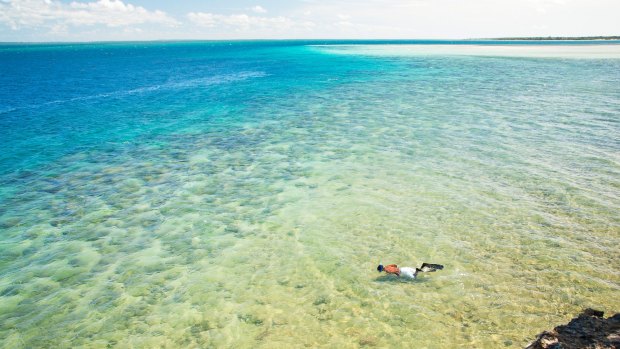
Azura Quilalea, Mozambique.
Welcome to Mozambique, this year celebrating 25 years of peace since the end of a ruinous civil war, and one of today's most hotly tipped new tourist destinations.
While the south-east African country has always had far more than its fair share of natural beauty, with a 2500-kilometre-long coastline on the Indian Ocean facing Madagascar, and game parks with wildlife, it has only just emerged from a turbulent history.
But now declared completely mine-free, and with a huge investment in infrastructure, the creation of several beautiful tourist resorts, an increasing range of hotels in all price brackets and game airlifted in to repopulate its parks, it is ready and open for business.
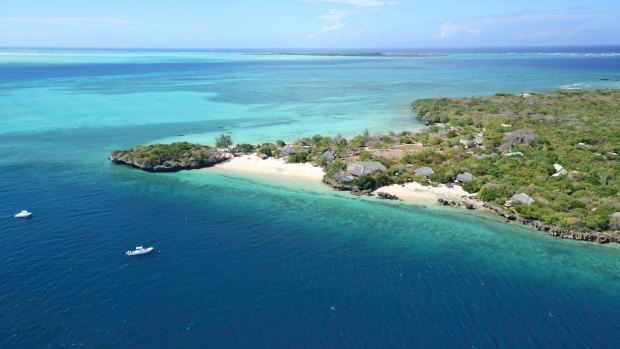
Mozambique's Azura Quilalea.
"It is such a beautiful place now," says Karleen Thornhill, the general manager of the lodge on Ibo Island in the north of the nation, who has previously worked in tourism in South Africa, Nigeria, Tanzania, Zanzibar and London. "It's had a lot of difficulty in the past, but it's through that now.
"With peace, and more prosperity, we're seeing the start of more people coming in to discover the place, and everyone loves it. I think it's going to have a big future in the world."
Today, however, it's still a relatively quiet, untouched destination, neighbouring Malawi, South Africa, Swaziland, Tanzania, Zambia and Zimbabwe, with a charm all its own. That Ibo Island, for instance, part of the Quirimbas Archipelago and just 70 nautical miles and a short boat or helicopter ride from the mainland at Pemba, is quiet and otherworldly dreamy, and enormously atmospheric.
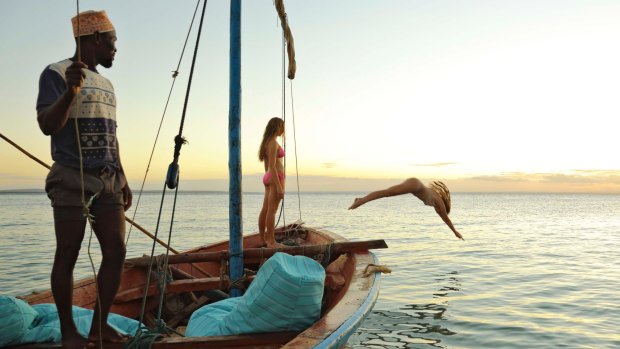
Visitors take to the water off Azura Quilalea.
Scarlet bougainvillea petals lie scattered over every little cobbled street, children stop and chat to any tourist they find on their way to school, and women weave gracefully through, carrying huge urns of fresh water on their heads from the local wells. Behind them are fine sand beaches, azure ocean and leafy mangrove swamps, all looking much as they did 200 years ago.
Ibo was originally used by the Portuguese colonialists as a shipping post for sending slaves over to service the plantations of Mauritius and Reunion. Then it became a wealthy trade centre, with magnificent public buildings, churches and no fewer than three grand forts. Later, during the war of independence against the Portuguese, the same forts were used to imprison the freedom fighters who eventually triumphed and liberated the country.
Now some of those buildings, like the fort of Sao Joao Baptista, constructed in 1791, have been preserved and are used by silversmiths fashioning delicate jewellery. Other buildings lie in crumbling ruins, or are slowly being brought back to life, some as accommodation for tourists.
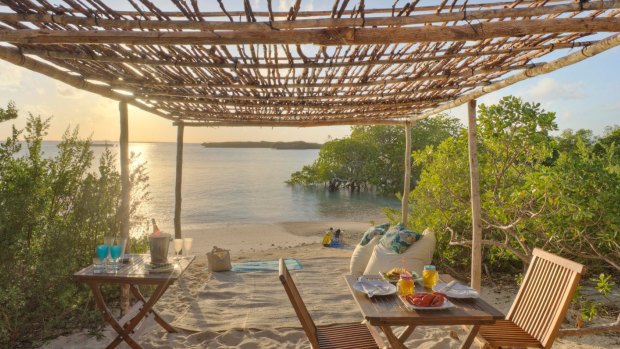
Sunset at Azura Quilalea.
The Ibo Island Lodge was formerly one of those old mansions, now converted into a luxury hotel of 14 huge rooms, looking out over either the sea or gardens, with wide verandahs, handcrafted furniture, two pools and an alfresco roof terrace restaurant and bar, with gorgeous ocean views.
Lodge owner Fiona Record, who chanced upon Ibo while travelling overland around Africa in the 1990s, fell in love with it immediately. "We found it quite by accident and a lot of good fortune," she says. "It has been criss-crossed over the centuries by explorers, pirates, ancient tribes, fishermen and smugglers.
"It was nearly destroyed by an ugly civil war and yet remains an island of great natural beauty and undiscovered archaeological, historic and anthropological treasure. It is an island full of surprises and a place we have come to love."
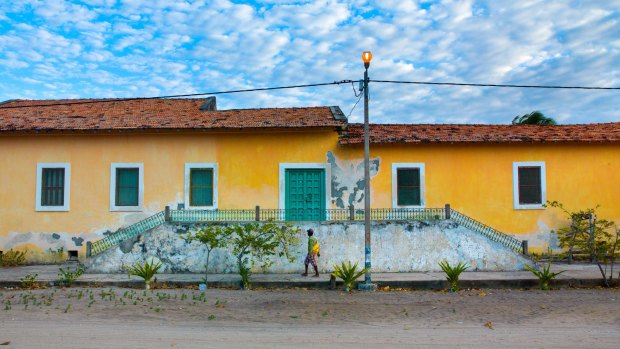
An old Portuguese colonial building, Ibo Island.Credit: Alamy
She and husband Kevin employed 120 of the inhabitants to help, most of whom couldn't speak a word of English, had no construction skills and didn't even understand what tourism was. Those locals couldn't believe, at first, that people would ever journey from their homes to go to a foreign place.
Now many have learnt English and become skilled in either building or hospitality, working at the lodge. There are moments of a mutual lack of comprehension between guests and staff, but most usually end in laughter, back slapping and handshakes. There is nothing like it to overcome cultural barriers.
Ibo has a peaceful old-world feel but still offers plenty to do, with guided sightseeing walks, bird tours, kayaking, dhow sailing, island-hopping, snorkelling, diving, dolphin-watching, fishing and a masseuse onsite in the lodge. Its food is exceptional, with plenty of lobster, fish brought in by the fishermen every day, prawns, crab and fresh fruit and vegetables.
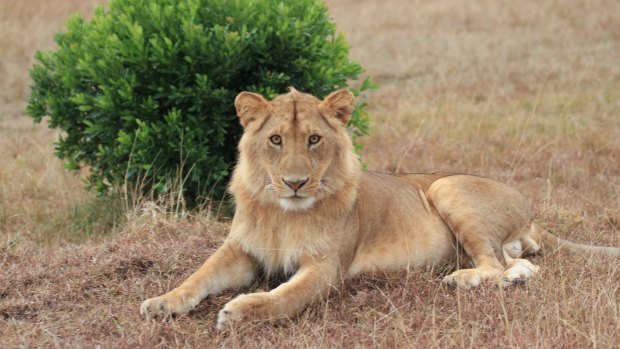
Young male lion.Credit: iStock
A regular sight on the island is women with white smeared over their faces. Is it tribal, you wonder, does it signify an unmarried woman ready to wed, or does it have some more unearthly significance? The answer surprises me. No, it's a local sunscreen face mask that the women wear to protect their skin against the fierce sun and soften their complexion. They are happy for visitors to try it, too.
Another short helicopter or boat ride away is the private island of Quilalea, on a marine sanctuary, home to the Azura Quilalea resort. If ever you were looking for a paradise on earth, this is as close as I can ever imagine coming.
The 34-hectare island is startlingly beautiful, in a marine sanctuary with a series of white sand beaches, giant baobabs in the forest in the middle, and crystal-clear water.
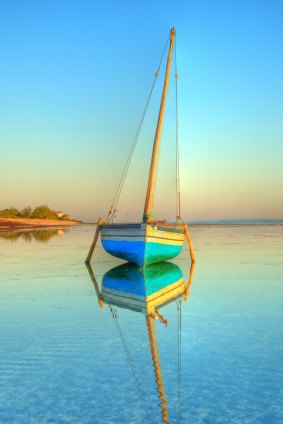
Dhow on the water on a picture-perfect morning.Credit: iStock
The resort has only nine luxury villas overlooking the ocean, each constructed with indigenous materials and handcrafted timbers, opening on to massive decks on to the beach with sun loungers and a day bed. The king-sized bed is draped in romantic African Arabian netting.
Staying there is a haven of five-star candlelit dining on the beach; water sports such as diving, snorkelling and kayaking; bird walks; romantic sunset dhow rides with dolphins; and even big tin baths on the deck filled with bubbles and rose petals and a chilled bottle of champagne close at hand.
Another highlight is a beautifully prepared picnic on a private beach – think cerviche, prawn kebabs, salad, bread and fresh fruit platters – complete with lounges, white-clothed tables and a giant sun shade. The water was like bathwater, while paddling in supplied booties around the mangroves … It's like being Robinson Crusoe for the day, but in heaven.
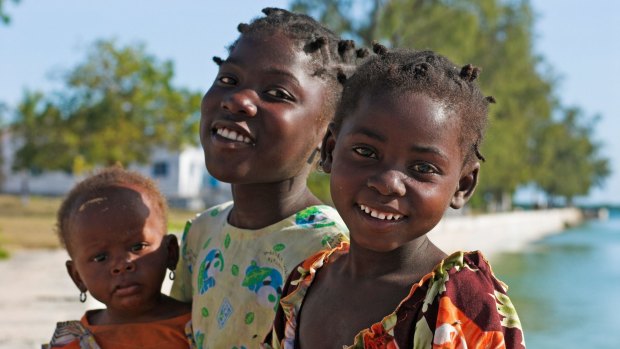
Children at Ibo Island.Credit: Alamy
If that's all not special enough, the spa is one of the most simple, but beautiful, I've ever seen. Carved into a cliff face, you ascend on rock stairs, take an alfresco shower then lie on a massage table looking out over the ocean, listening to the gentle wash of the waves as the masseuse does her work.
The same company has another resort on an island further south, the Azura Benguerra Island, also in a world-class marine national park. It's a little larger with 20 villas, and this time on an island that is also populated by locals which gives it a real community feel.
Between them lie other attractions. Mozambique Island, just three kilometres long and 550 metres wide, once played a massive role in East African coastal life as the meeting point of Arabic, African and European cultures, and is still a fascinating place with a living history.
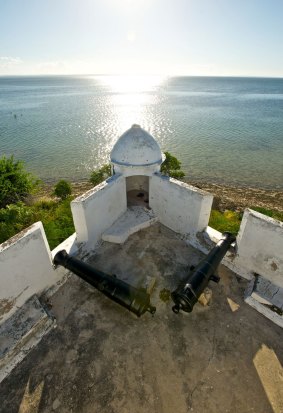
Canons on the 18th-century Sao Joao Fortress guarding Ibo Island. Credit: Alamy
Now a UNESCO World Heritage Site, many of the buildings in its old Stone Town were built in the early 16th century by the Portuguese while the more modern parts were constructed in the late 1800s. Today it teems with life amid the history.
A touch further south and inland, close to the Zimbabwean border, is the Gorongosa National Park, once one of southern Africa's pre-eminent wildlife parks, well known for its huge numbers of lion, elephant, rhino, hippo and buffalo. Its population was, however, decimated during the war – apart from the water buck that tends not to taste good to humans and other predators – but there has been a lot of work done to restore the park and bring animals back.
Australian specialist helicopter pilot Ron Innes has been a big part of that project, airlifting wildlife from neighbouring countries to repopulate Gorongosa. "There just weren't many animals left at all, but we've been busy restocking with zebra, eland, buffalo, everything," he says. "We'll also be taking in a couple of hundred elephants in the near future."
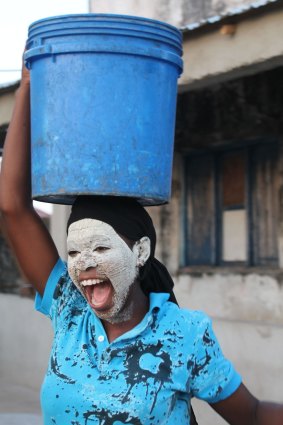
Carrying water on Ibo Island.Credit: Julia Salnicki
The park reopened to the public in 1998, and now has ever-growing herds of every kind of animal, including a huge variety of birdlife. "It is such a beautiful place now," says Sydneysider Innes, who spends most of his time in Africa with game capture and release units.
"It's a very special part of a very special country. The more it gets known, the more the tourists will come …"
COUNTRIES THAT HAVE RECOVERED FROM CIVIL WAR TO BECOME GREAT TOURIST DESTINATIONS
1. Sri Lanka
2. Vietnam
3. South Africa
4. Costa Rica
5. Croatia
6. Colombia
FLY
South African Airways (flysaa.com) flies to Johannesburg, and on to Maputo and Pemba in Mozambique. Other internal flights are with LAM, Mozambique Airlines, and the lodges organise transport to islands.
STAY
Ibo Island Lodge, see iboisland.com; Azura Quilalea and Azura Benguerra see azura-retreats.com; Mozambique Island, Hotel Escondido hotelescondido.com
Gorongosa see gorongosa.org All can be booked via The Classic Safari Company classicsafaricompany.com.au Ph (02) 9327 0666
Sue Williams travelled courtesy of The Classic Safari Company and South African Airways.
Sign up for the Traveller Deals newsletter
Get exclusive travel deals delivered straight to your inbox. Sign up now.